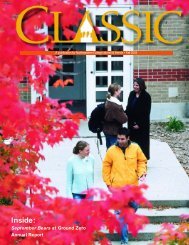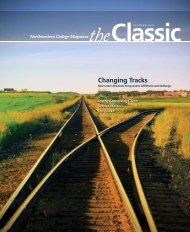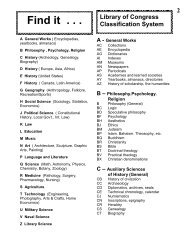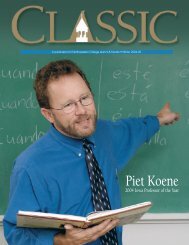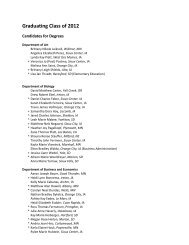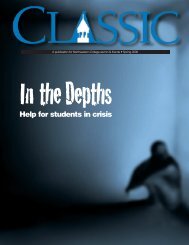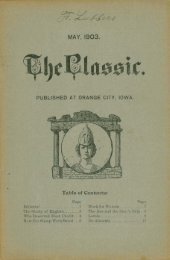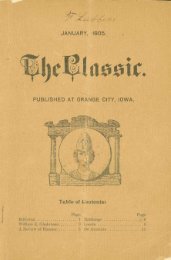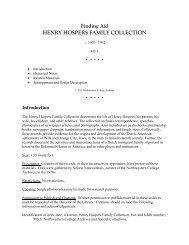Summer 2010 - Northwestern College
Summer 2010 - Northwestern College
Summer 2010 - Northwestern College
- No tags were found...
You also want an ePaper? Increase the reach of your titles
YUMPU automatically turns print PDFs into web optimized ePapers that Google loves.
COVER STORYCOVER STORYWhen we heard the screams, that’s when it really hit me whathad happened,” says Den Hartog, a 1981 <strong>Northwestern</strong>graduate who works as an orthopedic surgeon in Rapid City,S.D. “I knew there were going to be thousands of casualties, I knew weweren’t prepared for that, and I felt this hopeless, sinking feeling in myheart.”Den Hartog, his father, and two of his sons had arrived in Haiti onJan. 11, the day before the earthquake, as part of a 48-person constructionand medical team working with an organization called Missionto Haiti. Within minutes of the 7.0-magnitude quake, however, theirfocus changed from building a clinic and seeing patients to saving lives.As aftershocks rumbled through the area every 15 to 20 minutes, thetwo doctors and seven nurses on the team began treating the wounded.Because the clinic wasn’t finished—and because aftershocks made itdangerous to be in any building—triage was done outdoors onfolding tables. People arrived withleg and skull fractures, paralyzingspinal cord trauma, and open,contaminated crush injuries.“Five kids died in front ofus that night,” Den Hartogremembers. “We pulled two littlegirls, 2 and 4 years of age, out ofthe rubble, and then three otherkids died later on—one from acollapsed lung.”Without the proper equipmentand quickly running low onmedical supplies, Den Hartog andhis colleagues did what they could.Out of gauze, the team tore bedsheets into bandages. They cutplywood intended for the clinic’swalls into makeshift splints andadministered life- and limb-savingantibiotics.They worked through thenight, treating as many as 70Haitians by the light of headlampsand a yard light run by a generator.The next morning they drove15 critically injured patients to anearby hospital, only to discoverit had no running water, noelectricity and—at the time—nodoctors.“There were dozens of peopleADDISON DEN HARTOGin the courtyard of the hospital who needed treatment desperately, and itwas so frustrating we couldn’t deliver that for them,” Den Hartog says.The quake created chaos in a country with little infrastructure and anominal emergency medical system. The team contacted six differentembassies and the Red Cross, offering to help and pleading for medicalsupplies, but was stymied by a lack of communication and coordination.Finally, running low on food and water and with security becoming anissue, they began searching for a way to leave the country.Fifty miles north of Port-au-Prince, Kristie (De Boer ’95)Mompremier and her husband, JeanJean, were standing by theirFord pickup when it began rocking up and down, its springssqueaking. The stone bench their daughters were sitting on swayedback and forth, and inside the house, pictures fell off the walls. Initialexcitement at having experiencedan earthquake, however, soon gaveway to alarm when they learnedhow destructive the quake hadbeen in Port-au-Prince and theywere unable to reach family andfriends living in the city.Kristie first visited Haiti as anagricultural missionary a year aftergraduating from <strong>Northwestern</strong>.She fell in love with the countryand its people—and eventuallywith JeanJean, a Haitian secondarymath and physics teacher shemet at the mission where she wasworking. The two were marriedin 1998 and then spent four yearsin Orange City, where Kristieworked as a nurse while JeanJeancompleted an online seminarydegree.Moving back to Haiti, theMompremiers settled in JeanJean’shometown of Caiman, a small,poor community composed ofsubsistence farmers. With the helpof several friends, they foundedUnited Christians International,a ministry that works through thelocal church to teach the word ofIn Haiti on a mission trip when the earthquake struck,Dr. Bryan Den Hartog ’81 worked through the night treatingpeople injured by collapsed buildings and falling debris.God and equip Haitian leaders.JeanJean leads Bible seminarsfor Haitian pastors, many of whomhave had no formal training.CHRISTI GABHARTThe family of Kristie (De Boer ’95) Mompremier (center), a missionary inHaiti, housed as many as 35 refugees from Port-au-Prince in the monthsafter the earthquake. The disaster, she says, has made people moreopen to the good news about Jesus Christ.Kristie provides medical care and teaches public health. UCI also hasan agricultural ministry to help people support themselves. And whenthe Mompremiers saw children eating ashes because they were somalnourished, they started a feeding program that has grown to sevennutrition centers.Despite its distance from the epicenter of the quake, the Caimancommunity was deeply impacted by the disaster. JeanJean’s nephewsurvived after being buried overnight in the rubble of his medical schoolin Port-au-Prince, but seven sons and daughters of the Mompremiers’church friends perished in collapsed buildings. JeanJean conducted amemorial service for the victims. No bodies were recovered.For several weeks after the earthquake, the Mompremiers werehousing and feeding 35 refugees from Port-au-Prince. Four monthslater, they still had 19 houseguests. Those victims of the quake, however,have food and shelter. With southernHaiti now in its rainy season, hundredsof thousands of others are still living inmassive tent cities in Port-au-Prince andthe surrounding area.Even before the earthquake thatclaimed at least 230,000 lives,injured 300,000, and left an estimated 1 million people homeless,Haiti was the poorest country in the Americas. As much as 80 percent ofits population lives on less than $1.25 per day.But it wasn’t always so. When Columbus landed in 1492 on whatthe native Taínos called Ayiti—“Land of High Mountains”—he founda lush, tropical island paradise. The establishment of the first Europeansettlement in the New World, however, introduced a lethal combinationof infectious diseases, slavery and genocide that decimated the nativepopulation.“I never thought I would be holdingchildren at night as they cry themselvesto sleep longing for their mommies.”Looking for a new source of expendable manpower to cultivate sugarcane, the Spanish colonists began trafficking in slaves from Africa. Whenthe western third of the island was ceded to France, the practice ofslavery continued.Slaves and the goods they produced made the colony the Frenchrenamed Saint-Domingue the richest in the world. By the late 1700s,it supplied three-fourths of the world’s sugar; was a leader in theproduction of coffee, cotton, rum and indigo; and generated morerevenue for France than all 13 American colonies combined did forEngland.Saint-Domingue was arguably the most brutal slave colony of alltime. One out of every three slaves died within a few years of arriving onthe island. Despite such high mortality rates, at the close of the century,Saint-Domingue’s population included at least a half million slaves.Haiti’s birth as a nation began in 1791when 35,000 slaves rose up against theslaveholders, killing white colonists andburning plantations. For 12 years theyfought French, Spanish and Englishtroops sent to quell the rebellion. Morethan 150,000 slaves lost their lives in thebattle for independence.In 1804 the last European troops were driven from the island, andHaiti became the first sovereign “black” country in the modern worldand the only nation born of a slave revolt. But in the centuries thatfollowed, most Haitians would find themselves living under a differentkind of oppression: 200 years of exploitation, corruption and tyrannicalrule that played a major role in the devastating impact of the January<strong>2010</strong> earthquake.24 SUMMER <strong>2010</strong><strong>Northwestern</strong> Classic 25



